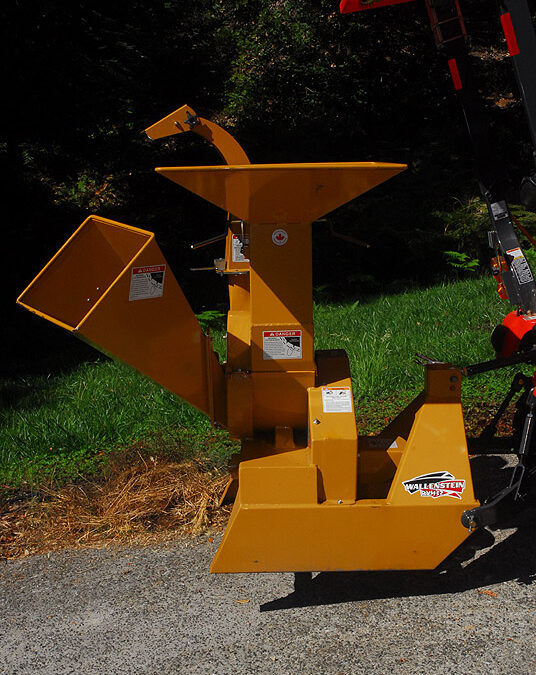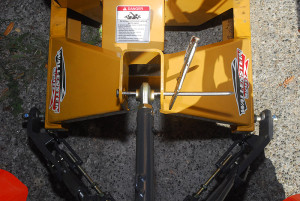There’s this strange phenomenon that occurs when a seemingly small tree is cut down. In early morning light, looking up at the top of the canopy of a small, scrubby, half-dead oak, one’s brain does something akin to new math. Estimating the approximate height of the tree, one figures maybe half an hour to forty-five minutes of bucking up the trunk into 20-inch or so logs, and maybe about the same to clear the canopy, and move it to the “to-be-chipped-and-shredded” pile. This is the same sort of reasoning that goes on while watching a 30-minute home improvement television show…you know, where they completely remodel a bedroom, splash of paint, new curtains, home-sewn bedding etc., and watching that sipping sunday morning coffee convinces you that it’s so easy, surely you can get all that done by yourself in time for dinner. Trees are the same. That innocent looking spindly stick on the hill, lays out across the driveway, maybe cracking into two or three trees on the other side of the road on the way down, and becomes a two-day project, leaving behind a massive pile of twigs and branches that a small army would take four or five days to clear.
Although the hillside is essentially cleared, in its wake is a somewhat daunting pile of what foresters like to call ‘slash’. All the canopy twigs, branches and leaves, that in a more damp climate could simply be burned. In this part of California, although you can burn these materials between December 1st and April 30th, burning is strictly prohibited at other times of the year due to our paucity of rainfall during that time. However, leaving these materials in place waiting for burn season is a fire hazard in and of itself, and with the recent fires in the area, I’ve been getting a little jumpy lately having all this fuel laying around the property. As such, the newest addition to the farm arsenal is “Wally”, a bouncing baby 450-pound Category-1 hitch, Wallenstein BXM32 chipper/shredder.
Wally arrived yesterday at our local feed store via the freight shipper. We needed a loading dock for delivery, and as we don’t have one here, nor a suitable substitute because of our hills and winding roads, our local feed store was kind enough to allow us to have Wally dropped at their loading dock. We borrowed a neighbor’s pickup truck, and Wally was fork-lifted into the back of the truck. All rather straightforward so far, right? So, Wally arrives here, and then begins the logistical nightmare of trying to encourage Wally out of the truck, without the aid of a forklift.
There isn’t much here that one could call flat. Mostly just rolling acres of everything from greater than 2 in 1 slopes, to sheer drop-offs near the creek, and everything, except flat, in between. Initially we had hoped we might be able to wiggle Wally out of the back of the truck with the front-loader on the tractor. However, Wally is a bit more rotund and front-heavy than we expected, and my often overactive imagination just couldn’t envision that process going as well as hoped. The second attempt was to try to find a place around here where we could situate the rear end of the tractor high enough so the 3-point hitch could line up with Wally, and we could just lift it out of the pickup with the hitch. I tried backing the Kubota up what seemed like the perfect short slope, but as I backed up the slope, as I don’t weigh enough in the tractor seat, the kill-switch would stop the engine and I couldn’t make it far enough up the slope. Ok, plan A AND plan B didn’t work. We’re smart, we’ll just have to come up with a plan C.
My next crazy idea, using the same short slope, and the cooperation of two young redwood trees and a come-along winch, was to winch Wally, with the attached shipping palette, out of the truck, and slide it onto the top of the slope. We backed the pickup truck against the slope, removed the lift-gate on the truck, attached the winch to the palette, and started sliding Wally out of the truck. Did I mention Wally is 450 pounds? Did I remember to mention that there’s a steep drainage gully just to the right of where Wally was sliding out of the truck? Did I say this was a crazy idea? Ok, good, didn’t want to forget those small details. Everything was going remarkably well actually. The flat bed on the truck lined up fairly well with the top of the slope, we used a couple of old pieces of lumber as skids for the palette. However, we had one brief terrifying moment where gravity versus top-heavy Wally almost rolled the chipper head-first into the ditch just as the last of the palette freed itself from the truck. Thankfully, we caught Wally, and convinced it to stay upright at the top of the slope. Perfect, Wally was finally out of the truck, whew! We’re done! Well…not quite…
Our soil is very sandy, and the rear tires of the truck were now off the road…the truck of course is rear-wheel drive (and NOT a four wheel off-road vehicle). Yes yes, you guessed it, we now had the truck stuck in the dirt. Why are these things never simple? However, the truck was now 450 pounds lighter, and thankfully I do have a 4-wheel SUV on the property. A tow chain, four-wheel drive, and a short tug, quickly liberated the truck from the soft soil, and it was returned unscathed to the neighbors who had missed seeing the previous two hours of entertainment. Really, nobody needs that much excitement in life!
Wally sat proudly perched on the hill, still way up, nowhere near where the tractor hitch could reach it. We still had the same problem we started with, it was just a little different now. However, the slope wasn’t that high, and we just figured we’d separate Wally from the shipping palette, and slide it carefully down the hill, at least gravity would be in our favor this time. Remarkably, that part went quite well, so I grabbed the tractor, backed it up to the hitch mount, and we started trying to convince Wally to attach to the 3-point hitch. There’s a nifty little capped plastic tube attached to Wally for storing all the locking pins that are used to secure Wally to the tractor hitch. However, the vendor neglected to check that the pins were packed inside that storage compartment. DOH! We finally had Wally where it needed to be, level with the hitch, had the tractor in position, and no way to connect the two together! Did I mention it is now getting dark? Refusing to be thwarted, while we’re so close to getting Wally off the driveway, we used a couple of chute-casing bolts, and a very large 10 inch long nail-spike leftover from a patio edging project, and temporarily attached Wally to the tractor.
So, we can’t quite use Wally just yet, until the locking pins arrive and we’ve installed the PTO shaft, but at least Wally is off the truck, off the slope, out of the driveway, still in one piece, and almost ready to be put to lots of good use around here!










